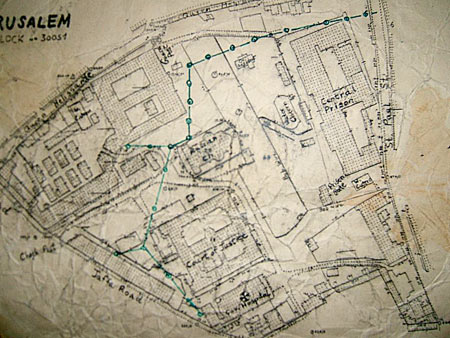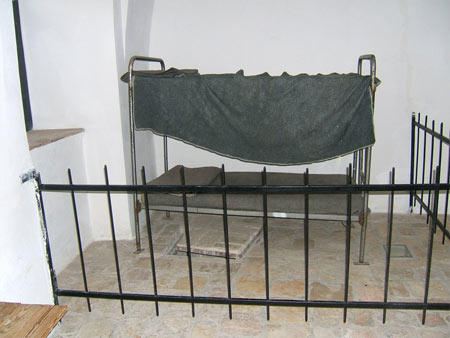Escape Cell #23
Until the summer of 1947, this room was occupied by "Hagana" prisoners. With the release of the majority of these men, "Lehi" prisoners were confined to this room. Some of the prisoners had enough time on their hands to carve their names and unit symbols into the paving stones. The aftermath of the U.N. resolution of 29 November 1947 to partition Palestine, and the Arab attacks on Jewish populated areas, fueled the prisoners' aspirations to escape from prison to join their fighting brethren outside the prison walls in battles of the War of Independence. Assisted by a Jewish employee of the Municipality's Public Works Department who had free access to the prison in the capacity of his job, the prisoners secretly obtained a regional map and from it learned that the main sewage pipe passed next to the main wall.  | | | A map showing the route of the escape tunnel connecting to the sewage pipe | They decided to dig a tunnel and connect to the sewage pipe. The hardest problem of all was: where would they dump the dirt they dug? Finding no satisfactory solution, the prisoners approached the warden and complained about how difficult it was to sweep water out of their room during the morning clean-up, because the cell was large and its floor was lower than that of the corridor... "Therefore," they told him, "we request permission that next to the doorway we dig a pool, into which we will sweep the water, and then collect this water into a bucket." The warden responded sympathetically and affirmatively to their request, even providing the necessary tools: cement for the pool and a wheelbarrow for dirt removal. Now they even had the proper tools to realize their idea. Naturally, to each wheelbarrow of sand they dumped, they added dirt from the tunnel they were digging. The work took two months. Toward its completion, the Lehi prisoners let their Irgun comrades join the effort.  | | | Escape room tunnel entrance, hidden under an inmate's bed | On the day designated for the escape, their confidant, the Municipality employee, "made sure" that the prison sewage was clogged. He brought in several Jewish workers, who had been let in on the secret, to unclog it. The workers walked past the sentry at the gate of the Russian Compound, opened and entered the manhole, where they met the prisoners crawling from the tunnel. Over their prison fatigues, the prisoners put on uniforms given them by the workers, and made their way out into the Russian Compound. The sentry let them pass without any additional check, convinced that they were sewage workers. On February 20, 1948, twelve prisoners, members of both underground organizations, managed to escape right out of the front gate before the breakout was discovered by the guards. | |
